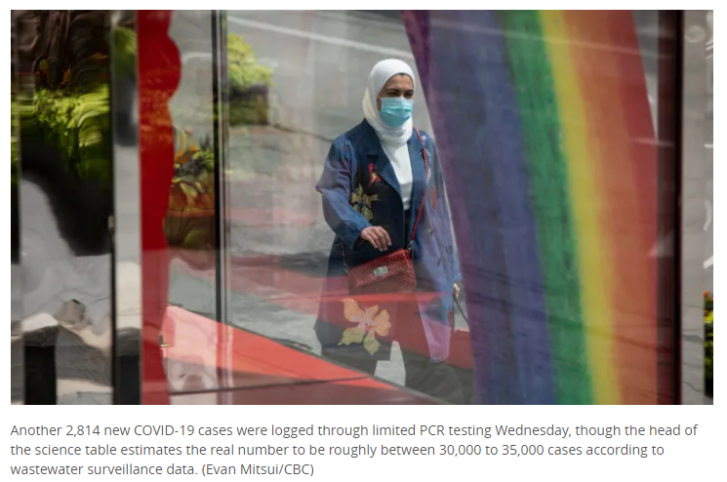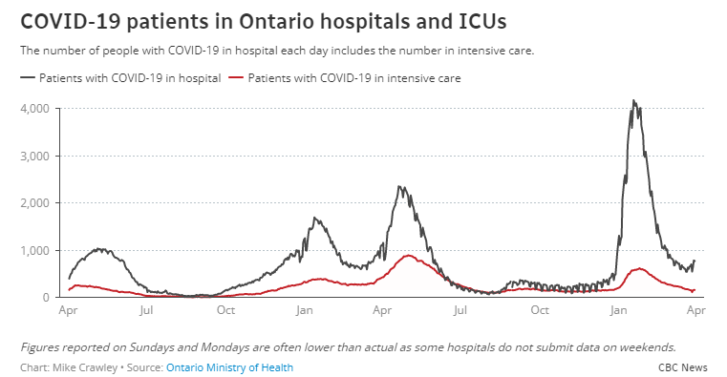Ontario reports 778 COVID-19 hospitalizations and 13 more deaths Wednesday
The Ford government will continue to provide free rapid antigen tests until at least the end of July as the head of the Ontario Science Advisory Table says the province is in the midst of a sixth wave of the COVID-19 pandemic.
In a statement Wednesday afternoon, Alexandra Hilkene, press secretary for Minister of Health Christine Elliott, said the province will be making tests available at grocery stores, pharmacies, as well as at workplaces, schools, hospitals, long-term care, retirement homes and other congregate settings until at least July 31.
“The province will also continue to provide free rapid antigen tests for asymptomatic screening in highest risk sectors,” she said.

In February, the province had said it would distribute 5.5 million rapid tests each week for a period of eight weeks.
The commitment comes as opposition politicians call on the Progressive Conservative government to expand access to PCR tests for the virus.
Critics have been calling for Ontario to reinstate broad access to the gold-standard tests, which have been restricted to certain high-risk groups since December when the Omicron variant overwhelmed resources.
Those calls ramped up Wednesday, but Elliott’s office says the PCR testing “continues to be readily available for those living and working in the highest-risk settings.”
‘Quite the steep increase’
The news comes as Dr. Peter Jüni, head of the COVID-19 Science Advisory Table, says the province is seeing the effect of easing of public health measures in the past few weeks — including the lifting of mask mandates in most settings and the end of gathering limits.
“We are in the middle of it, however we call it. It’s either the resurgence expected after the reopening of the last wave or you can call it the sixth wave,” Jüni told CBC News Wednesday morning.
Jüni added that Ontario is seeing “quite the steep increase” in wastewater predominantly, something he says is generally followed by an increase in hospital occupancy.
Ontario reported 778 people hospitalized with COVID-19 Wednesday as health experts are cautioning people to keep wearing masks as the province sees a rise in hospital occupancy in the wake of public health measures being lifted.
Experts predicted a rise in cases and hospitalizations with measures lifting, but urged Ontarians to continue being cautious and wear a mask in busy indoor environments.
Jüni said the latest projections made by the science table that predicted an increase in hospital occupancy will need to be re-evaluated based on the behaviour health experts are seeing. Those predictions saw an increase of hospitalizations, though not one as high as the peak of the Omicron wave of the pandemic.
New COVID wave underway
Jüni said that he doesn’t anticipate the burden on the province’s health-care system will be as high as previous waves due to high vaccination rates but notes it is difficult to know how big of an impact it will have.
He continued to urge Ontarians to take precautions.
“We should change our behaviour only moderately and slowly to make sure that the upward slope is not too steep.”
Dr. Isaac Bogoch, an infectious diseases expert with University Health Network, said it’s “pretty clear” wastewater signals are trending upwards, also noting that another wave is underway.
“There’s more COVID now than there was a week or two ago, [but] the real question here is ‘How big will this wave be? not ‘Is there a wave?'” Bogoch told CBC News Tuesday.
“I don’t think it’s going to be as big as the wave we just had [but] again it’s going to be something.”
Wastewater surveillance data is helpful for experts to project the virus transmission in specific areas and how that will impact hospitals in coming days or weeks while figures such as hospitalizations and ICU occupancy are “delayed metrics,” he noted.
Bogoch noted that while the highly-contagious subvariant BA.2 is more transmissible, vaccines continue to offer high levels of protection against serious illness for both the subvariant and Omicron.
For now, Bogoch is encouraging people to continue wearing masks as they remain effective in lowering the risk of transmission and creating safer indoor environments.
In a statement to CBC News Wednesday, the Ministry of Health said the province’s Chief Medical Officer of Health, Dr. Kieran Moore, will continue to monitor the data and evidence on an “ongoing basis.
“As Dr. Moore has previously said, indicators are expected to rise as Ontarians increasingly interact with one another. However, thanks to our high vaccination rates and natural immunity, as well as the arrival of antivirals, Ontario has the tools necessary to manage the impact of the virus,” the statement reads.
The province did not specifically say if it plans to re-introduce any public health measures. All remaining requirements are set to end on April 27, according to Ontario’s reopening plan.
“The latest modelling shows that our hospitals and health system can manage any of the projected scenarios, while not compromising our ability to continue addressing the surgical backlog caused by the pandemic,” the ministry added.
778 hospitalized, 13 more deaths
The number of hospitalizations reported Wednesday is slightly down from 790 a day before although it is up from 611 one week ago.
Of the hospitalizations reported, the number of patients in intensive care remained the same as the day before, with the Ministry of Health reporting 165 today. That’s down from 174 at the same time last week.
Of those hospitalized, 50 per cent were admitted specifically for treatment of symptoms brought on by the virus, while the rest were admitted for other reasons and then tested positive. Meanwhile, 73 per cent of people in ICU were admitted because of COVID-19, while the rest were added for other reasons, then tested positive for the virus.

Thirteen more deaths were also reported, bringing the total death toll in the province to 12,427.
Another 2,814 new COVID-19 cases were logged through limited PCR testing Wednesday, though the science table estimates the real number to be roughly between 30,000 to 35,000 cases according to wastewater surveillance data.
Here are some other key pandemic indicators and figures from the Ministry of Health’s daily provincial update:
Active cases: 17,309.
Provincewide test positivity rate: 15.1, up from Tuesday’s rate of 14.4 per cent.
Patients in ICU requiring a ventilator to breathe: 94.
Long-term care homes in outbreak: 56.
Vaccinations:8,484 vaccine doses were administered on Tuesday in Ontario with a total of 32,054,772 given out to date. Just over 89.9 per cent of Ontarians aged five or older have received at least one dose, while just over 86.4 per cent have received two doses.
Article From: CBC news
Author: With files from Linda Ward and The Canadian Press

